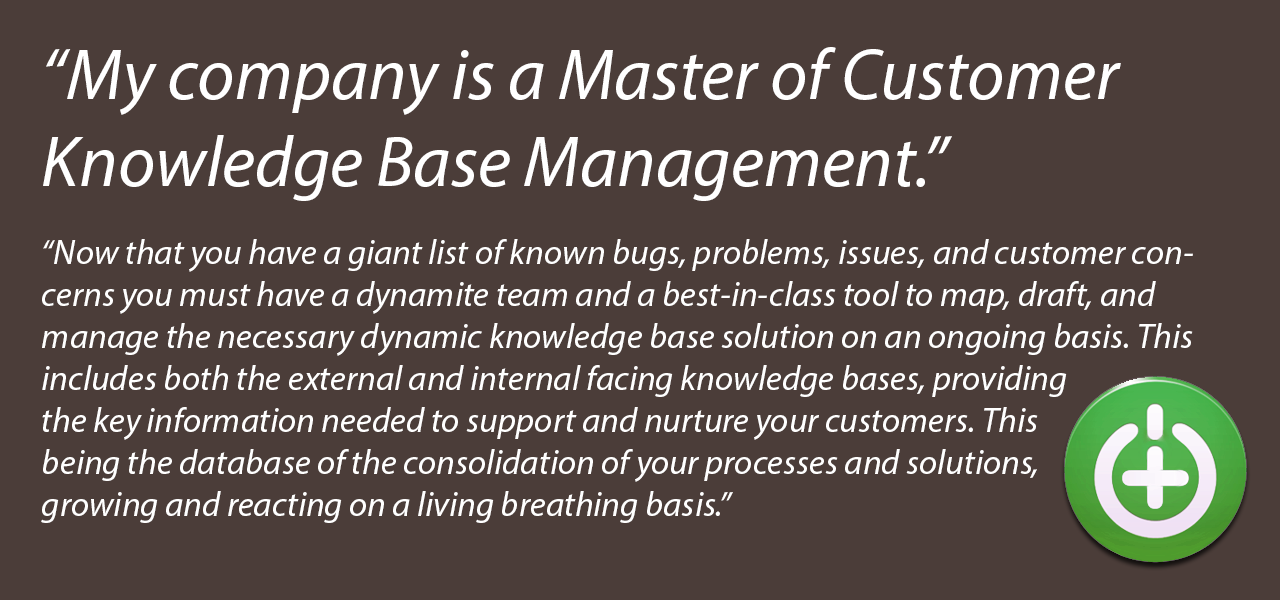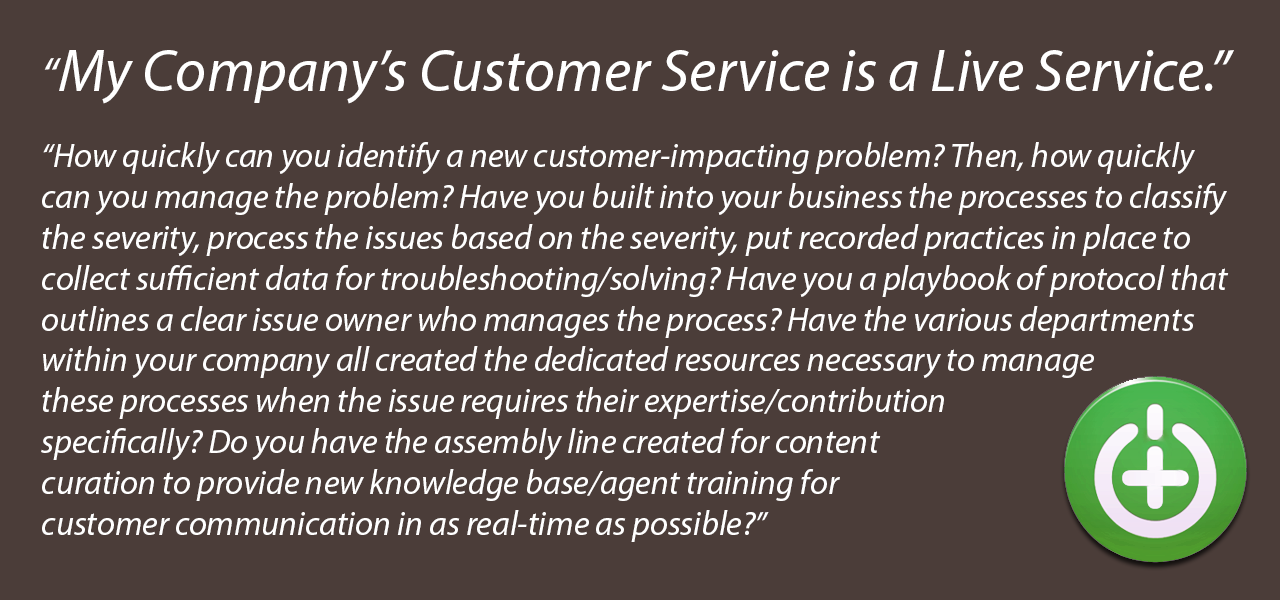- “My Company Excels at Issue Tracking”.
Customer journey mapping is so hot right now. Having a detailed step-by-step graphical representation of your customer’s interactions, touch-points, decision matrices, and end-points is an invaluable contributor in steering your business operations and trajectory. Anyone who has gone through this effort, understands how incredibly valuable it can be.
Issue tracking is much like this, only instead of mapping your customer’s journey…your mapping individual customer issues, complaints, problems, bugs, roadblocks – specifically, one at a time.
This activity must include the ability to create individual tickets for each problem, classification of each of these problems by type, sub-type, etc. and processes for handling, including an ongoing record of activities taken on each ticket (problem/issue) from start to finish. In the same way you can follow the customer’s life-cycle through your company…you should be able to do the same for every problem that your customer faces.
I recently encountered a company where they carefully tracked all call volumes, and classified each call received or made. As I dug deeper, I was horrified to discover that was as far as their customer support tracking went. While nice to know, this information was essentially useless towards improving the business, the services team, or the company by itself. While it was super neato to know that they had 2000 calls last month related to issue #1. There was no way to know how many of these were repeat calls, how many of these calls may have had multiple problems as customers, what the total time was to resolve the various issues on average (much less issue #1 by itself), (and most importantly) how many of these calls were ever even successfully resolved for the customer (!!!), etc. etc.
Contrast this with most companies I have worked with where every customer issue resulted in a ticket within our CRM. These issues were categorized systematically by type and sub-type. Tickets were tracked, processed, and recorded. We knew every type of contact we received, how many were repeat contacts, actions taken for each and every customer issue, resolution percentages, first time fix rates, and on and on.
This is basic stuff here folks, but it’s amazing how many companies I’ve seen who have missed the boat here completely!
- “My company is a Master of Customer Knowledge Base Management.”
Now that you have a giant list of known bugs, problems, issues, and customer concerns you must have a dynamite team and a best-in-class tool to map, draft, and manage the necessary dynamic knowledge base solution on an ongoing basis. This includes both the external and internal facing knowledge bases, providing the key information needed to support and nurture your customers. This being the database of the consolidation of your processes and solutions, growing and reacting on a living breathing basis.
The most basic example I can think of is the pesky password reset issue. Is there an FAQ article on your website on how to do it? Is there a searchable article created that pops-up when the customer comes to your support portal on the web and asks this question? Is there an internal-facing article detailing the step-by-step talking points in your knowledge base that your agents can use on a phone call, pre-written macros that can be dropped into the chat when the question comes up, a twitter link, a pre-drafted Facebook blurb, and/or pre-drafted email paragraph that can be sent out to the customer? There should be. These should all be accurately created, logged, managed, and maintained.
The best content management systems out there not only provide these core services, but many more such as: tagging of each article created, links to bind them, and intelligent reminder systems. Imagine that your development team determines that your current password protection practices need tightening up; you’re going to switch to a stronger protocol. This change would affect nearly all of the original instructions and articles in your knowledge base specific to “How to change your password”. With these additional features the system prompts your learning & development team members to double check the 187 other articles tagged with the word “password”, specifically calling up those additional articles that are linked to the original knowledge base article, and based on your settings could even prompt you to check them again in 6 months to be sure that nothing has changed and if they have become outdated, incorrect, or replaced.
Even a company with the simplest of products or services will quickly discover a massive amount of matrixed content that needs to be created, curated, and managed carefully on an ongoing basis.
- “My Company’s Customer Service is a Live Service.”
When I launched support for Star Wars: The Old Republic for BioWare at Electronic Arts in the winter of 2011, the software for the game could fill 2.5 DVD ROMS, included 8 key class types, with over 8000 hours of playable game content. Our bug tracking software had 3 categories of known bugs with totals not in the hundreds, but thousands. As you can imagine, our knowledge base database was MASSIVE.
We’d spent months in alpha and beta periods of the product constantly mapping, detailing, and pushing content for support. Training processes were heavy and it was critical to know in absolute detail what our product’s problems were as they came up and more importantly how to fix them. Through these trial live periods, we accurately captured our issues through exceptional issue tracking tools, and created the best knowledge base solutions and articles we could. Our launch to our global audience was an amazing one, and incredibly successful. We managed 2.6 million contacts within the first 6 week after launch.
However, as my dear boss and mentor had been oft to remind me over the two-year setup period, despite an ongoing and diligent QA review process – we would be launching with over 10,000 unknown bugs in the code. As with all software offerings, these issues would surface in varying degrees of severity and impact, from complete game file corruption to the occasional “floating rocks” flying out in the open of the game. So while it was fantastic that our CEO could comfortably say #1 and #2 above, #3 became the most important statement once live in the market.
How quickly can you identify a new customer-impacting problem? Then, how quickly can you manage the problem? Have you built into your business the processes to classify the severity, process the issues based on the severity, put recorded practices in place to collect sufficient data for troubleshooting/solving? Have you a playbook of protocol that outlines a clear issue owner who manages the process? Have the various departments within your company all created the dedicated resources necessary to manage these processes when the issue requires their expertise/contribution specifically? Do you have the assembly line created for content curation to provide new knowledge base/agent training for customer communication in as real-time as possible?
This is no small piece of work, and the backbone of your actual customer experience.
We crafted all of these, creating a dynamic 24/7 manager on duty process to essentially quarterback this process from new issue identification to customer communication, and everything in between. We were completely incorporated into all the key parts on the business in order to correctly steer each emerging issue, and then drafting the processes once solutions were identified, training, and including them in the external and internal knowledge bases as they happened. We were integrated into the business like a living nervous system. We had our fingers on the heartbeat of our customer.
This was LIVE customer service and support.
If you can say all of these three statements with confidence, then you not only know your product/service incredibly well…but you know your customer intimately, in real-time, and have created a living relationship with them.
Kudos to you. Keep it up.



